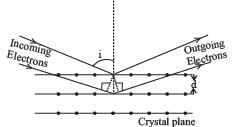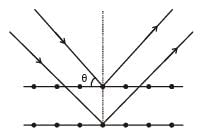JEE Exam > JEE Questions > Wave property of electrons implies that they ...
Start Learning for Free
Wave property of electrons implies that they will show diffraction effects. Davisson and Germer demonstrated this by diffracting electrons from crystals. The law governing the diffraction from a crystal is obtained by requiring that electron waves reflected from the planes of atoms in a crystal interfere constructively (see figure).

Q. Electrons accelerated by potential V are diffracted from a crystal. If d = 1Å and i = 30°, V should be about (h = 6.6 × 10 – 34 Js, me = 9.1 × 10–31 kg, e = 1.6 × 10 – 19 C)
- a)2000 V
- b)50 V
- c)500 V
- d)1000 V
Correct answer is option 'B'. Can you explain this answer?
| FREE This question is part of | Download PDF Attempt this Test |
Verified Answer
Wave property of electrons implies that they will show diffraction eff...
Using Bragg's equation 2d sinθ = nλ
Here n = 1, θ = 90 – i = 90 – 30 = 60°
∴ 2d sin θ = λ ......(i)
∴ 2d sin θ = λ ......(i)




|
Explore Courses for JEE exam
|

|
Similar JEE Doubts
Wave property of electrons implies that they will show diffraction effects. Davisson and Germer demonstrated this by diffracting electrons from crystals. The law governing the diffraction from a crystal is obtained by requiring that electron waves reflected from the planes of atoms in a crystal interfere constructively (see figure).Q.Electrons accelerated by potential V are diffracted from a crystal. If d = 1Å and i = 30°, V should be about (h = 6.6 × 10 – 34 Js, me = 9.1 × 10–31 kg, e = 1.6 × 10 – 19 C)a)2000 Vb)50 Vc)500 Vd)1000 VCorrect answer is option 'B'. Can you explain this answer?
Question Description
Wave property of electrons implies that they will show diffraction effects. Davisson and Germer demonstrated this by diffracting electrons from crystals. The law governing the diffraction from a crystal is obtained by requiring that electron waves reflected from the planes of atoms in a crystal interfere constructively (see figure).Q.Electrons accelerated by potential V are diffracted from a crystal. If d = 1Å and i = 30°, V should be about (h = 6.6 × 10 – 34 Js, me = 9.1 × 10–31 kg, e = 1.6 × 10 – 19 C)a)2000 Vb)50 Vc)500 Vd)1000 VCorrect answer is option 'B'. Can you explain this answer? for JEE 2024 is part of JEE preparation. The Question and answers have been prepared according to the JEE exam syllabus. Information about Wave property of electrons implies that they will show diffraction effects. Davisson and Germer demonstrated this by diffracting electrons from crystals. The law governing the diffraction from a crystal is obtained by requiring that electron waves reflected from the planes of atoms in a crystal interfere constructively (see figure).Q.Electrons accelerated by potential V are diffracted from a crystal. If d = 1Å and i = 30°, V should be about (h = 6.6 × 10 – 34 Js, me = 9.1 × 10–31 kg, e = 1.6 × 10 – 19 C)a)2000 Vb)50 Vc)500 Vd)1000 VCorrect answer is option 'B'. Can you explain this answer? covers all topics & solutions for JEE 2024 Exam. Find important definitions, questions, meanings, examples, exercises and tests below for Wave property of electrons implies that they will show diffraction effects. Davisson and Germer demonstrated this by diffracting electrons from crystals. The law governing the diffraction from a crystal is obtained by requiring that electron waves reflected from the planes of atoms in a crystal interfere constructively (see figure).Q.Electrons accelerated by potential V are diffracted from a crystal. If d = 1Å and i = 30°, V should be about (h = 6.6 × 10 – 34 Js, me = 9.1 × 10–31 kg, e = 1.6 × 10 – 19 C)a)2000 Vb)50 Vc)500 Vd)1000 VCorrect answer is option 'B'. Can you explain this answer?.
Wave property of electrons implies that they will show diffraction effects. Davisson and Germer demonstrated this by diffracting electrons from crystals. The law governing the diffraction from a crystal is obtained by requiring that electron waves reflected from the planes of atoms in a crystal interfere constructively (see figure).Q.Electrons accelerated by potential V are diffracted from a crystal. If d = 1Å and i = 30°, V should be about (h = 6.6 × 10 – 34 Js, me = 9.1 × 10–31 kg, e = 1.6 × 10 – 19 C)a)2000 Vb)50 Vc)500 Vd)1000 VCorrect answer is option 'B'. Can you explain this answer? for JEE 2024 is part of JEE preparation. The Question and answers have been prepared according to the JEE exam syllabus. Information about Wave property of electrons implies that they will show diffraction effects. Davisson and Germer demonstrated this by diffracting electrons from crystals. The law governing the diffraction from a crystal is obtained by requiring that electron waves reflected from the planes of atoms in a crystal interfere constructively (see figure).Q.Electrons accelerated by potential V are diffracted from a crystal. If d = 1Å and i = 30°, V should be about (h = 6.6 × 10 – 34 Js, me = 9.1 × 10–31 kg, e = 1.6 × 10 – 19 C)a)2000 Vb)50 Vc)500 Vd)1000 VCorrect answer is option 'B'. Can you explain this answer? covers all topics & solutions for JEE 2024 Exam. Find important definitions, questions, meanings, examples, exercises and tests below for Wave property of electrons implies that they will show diffraction effects. Davisson and Germer demonstrated this by diffracting electrons from crystals. The law governing the diffraction from a crystal is obtained by requiring that electron waves reflected from the planes of atoms in a crystal interfere constructively (see figure).Q.Electrons accelerated by potential V are diffracted from a crystal. If d = 1Å and i = 30°, V should be about (h = 6.6 × 10 – 34 Js, me = 9.1 × 10–31 kg, e = 1.6 × 10 – 19 C)a)2000 Vb)50 Vc)500 Vd)1000 VCorrect answer is option 'B'. Can you explain this answer?.
Solutions for Wave property of electrons implies that they will show diffraction effects. Davisson and Germer demonstrated this by diffracting electrons from crystals. The law governing the diffraction from a crystal is obtained by requiring that electron waves reflected from the planes of atoms in a crystal interfere constructively (see figure).Q.Electrons accelerated by potential V are diffracted from a crystal. If d = 1Å and i = 30°, V should be about (h = 6.6 × 10 – 34 Js, me = 9.1 × 10–31 kg, e = 1.6 × 10 – 19 C)a)2000 Vb)50 Vc)500 Vd)1000 VCorrect answer is option 'B'. Can you explain this answer? in English & in Hindi are available as part of our courses for JEE.
Download more important topics, notes, lectures and mock test series for JEE Exam by signing up for free.
Here you can find the meaning of Wave property of electrons implies that they will show diffraction effects. Davisson and Germer demonstrated this by diffracting electrons from crystals. The law governing the diffraction from a crystal is obtained by requiring that electron waves reflected from the planes of atoms in a crystal interfere constructively (see figure).Q.Electrons accelerated by potential V are diffracted from a crystal. If d = 1Å and i = 30°, V should be about (h = 6.6 × 10 – 34 Js, me = 9.1 × 10–31 kg, e = 1.6 × 10 – 19 C)a)2000 Vb)50 Vc)500 Vd)1000 VCorrect answer is option 'B'. Can you explain this answer? defined & explained in the simplest way possible. Besides giving the explanation of
Wave property of electrons implies that they will show diffraction effects. Davisson and Germer demonstrated this by diffracting electrons from crystals. The law governing the diffraction from a crystal is obtained by requiring that electron waves reflected from the planes of atoms in a crystal interfere constructively (see figure).Q.Electrons accelerated by potential V are diffracted from a crystal. If d = 1Å and i = 30°, V should be about (h = 6.6 × 10 – 34 Js, me = 9.1 × 10–31 kg, e = 1.6 × 10 – 19 C)a)2000 Vb)50 Vc)500 Vd)1000 VCorrect answer is option 'B'. Can you explain this answer?, a detailed solution for Wave property of electrons implies that they will show diffraction effects. Davisson and Germer demonstrated this by diffracting electrons from crystals. The law governing the diffraction from a crystal is obtained by requiring that electron waves reflected from the planes of atoms in a crystal interfere constructively (see figure).Q.Electrons accelerated by potential V are diffracted from a crystal. If d = 1Å and i = 30°, V should be about (h = 6.6 × 10 – 34 Js, me = 9.1 × 10–31 kg, e = 1.6 × 10 – 19 C)a)2000 Vb)50 Vc)500 Vd)1000 VCorrect answer is option 'B'. Can you explain this answer? has been provided alongside types of Wave property of electrons implies that they will show diffraction effects. Davisson and Germer demonstrated this by diffracting electrons from crystals. The law governing the diffraction from a crystal is obtained by requiring that electron waves reflected from the planes of atoms in a crystal interfere constructively (see figure).Q.Electrons accelerated by potential V are diffracted from a crystal. If d = 1Å and i = 30°, V should be about (h = 6.6 × 10 – 34 Js, me = 9.1 × 10–31 kg, e = 1.6 × 10 – 19 C)a)2000 Vb)50 Vc)500 Vd)1000 VCorrect answer is option 'B'. Can you explain this answer? theory, EduRev gives you an
ample number of questions to practice Wave property of electrons implies that they will show diffraction effects. Davisson and Germer demonstrated this by diffracting electrons from crystals. The law governing the diffraction from a crystal is obtained by requiring that electron waves reflected from the planes of atoms in a crystal interfere constructively (see figure).Q.Electrons accelerated by potential V are diffracted from a crystal. If d = 1Å and i = 30°, V should be about (h = 6.6 × 10 – 34 Js, me = 9.1 × 10–31 kg, e = 1.6 × 10 – 19 C)a)2000 Vb)50 Vc)500 Vd)1000 VCorrect answer is option 'B'. Can you explain this answer? tests, examples and also practice JEE tests.

|
Explore Courses for JEE exam
|

|
Suggested Free Tests
Signup for Free!
Signup to see your scores go up within 7 days! Learn & Practice with 1000+ FREE Notes, Videos & Tests.























